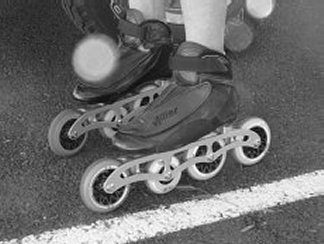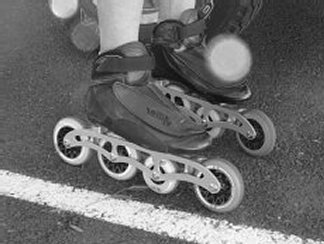|
"Rocker" And Roll, Experimenting With Your Inline Skate Wheels |
|||
|
|
|||
|
|
|||
|
|||
|
ROCKERING v. When wheels on an inline skate are configured to simulate the curve of an ice skate blade to enhance maneuverability by shortening turning radius. As opposed to anti-rockering, all the wheels are the same size, but placed differently in the frame. Having skates aren't rockered means the axles and wheels are all at the same height. This is the way the skates come when you buy them (usually). Most skates allow you to change the height of some or all of the axles, to achieve a rockered or curved effect of the wheels. The curve of an ice skate blade allows the ice skater to turn tighter, carve harder and have less resistance to forward motion than a flat blade. This same idea can work for inline skaters when rockering the four wheels. Most skaters rocker their wheels by raising the heel and toe wheels (wheels 1 and 4) or lower the middle wheels (wheels 2 and 3). Repositioning the wheels will make your skates much more maneuverable and allow you to turn much more quickly. If you want to achieve dance or quick footwork, rockering your wheels will make those moves easier for you. Depending on your skates, there are various rockering configurations possible. If your skates can adjust the height of only the middle two wheels, you can have your skates flat or rockered. You can rocker your wheels by having oval spacers with an offset axle-hole; each spacer can have an up or down position. Check your frames next time you change your wheels, the spacer usually pops out and you can turn it up or down to change the shape of the axle hole. If you are unsure, check your in your owners manual or with a local skate shop for help. Racing skates are also adjustable, but only in the horizontal direction, allowing for a longer or shorter wheelbase.
Some skaters find rockering provides much more maneuverability due to the curved shape simulated of the wheels. Whether you rocker or not is really up to you. Here is something to consider when rockering your wheels, you will most likely feel less stable at first. Also, you will have less power of your stroke since you have only two contact points with the pavement. The heel and toe wheels.
|
Hockey players prefer to have their skates rockered for sharper turns on the court.
Speed Skaters keep their blades flat for more stability at high speeds (rockers at high speed will produce speed wobble).
Artistic skaters may also prefer rockered, for quick turns and maneuverability.
Extreme skaters may keep them flat or anti-rocker the wheels. The middle wheels will be harder and shorter then the heel and toe, creating an opposite curve of the skate wheels to allow for easier grinding of rails.
Recently, students have arrived with new skates that have a progressive placement of wheels, tall wheels in back (76mm on 3 & 4) and shorter wheels on the front (72mm on 1& 3). This brings your foot position closer to the ground, and can allow for a shorter frame length. The smaller wheels in front also allow for easier turning while the larger back wheels help gain a smoother ride and maintain speed longer. The downside comes when it is time to rotate.
|
More Articles From Inline Skate Resource: Skate Your Butt Off - A Guide to Skating Hills OK, Something is not right here, my feet hurt when I skate! Stretches and Warm Ups for Inline Skating On The Road Again, Traveling with your Inline Skates When Should I Replace My Helmet? How to Avoid, and Treat Blisters.
|
|
|
|
|||


